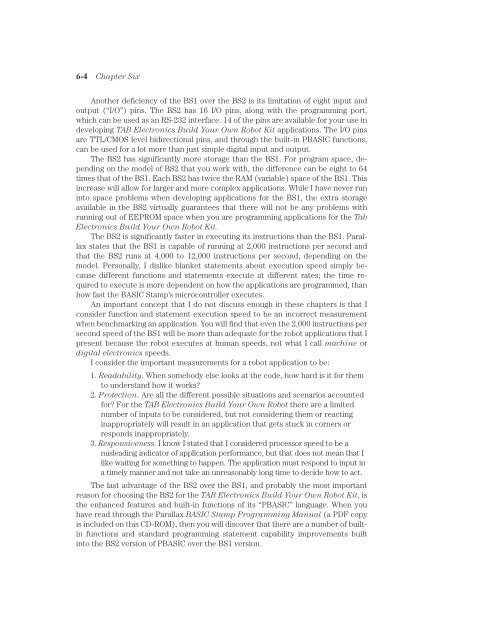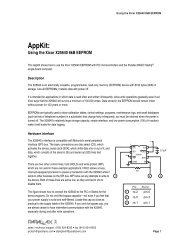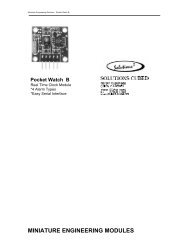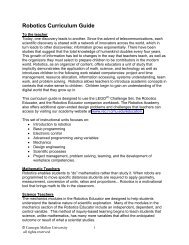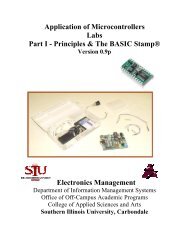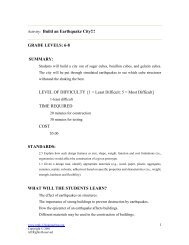Basic Stamp 2 Robot Programming - ISL
Basic Stamp 2 Robot Programming - ISL
Basic Stamp 2 Robot Programming - ISL
Create successful ePaper yourself
Turn your PDF publications into a flip-book with our unique Google optimized e-Paper software.
6-4 Chapter Six<br />
Another deficiency of the BS1 over the BS2 is its limitation of eight input and<br />
output (“I/O”) pins. The BS2 has 16 I/O pins, along with the programming port,<br />
which can be used as an RS-232 interface. 14 of the pins are available for your use in<br />
developing TAB Electronics Build Your Own <strong>Robot</strong> Kit applications. The I/O pins<br />
are TTL/CMOS level bidirectional pins, and through the built-in PBASIC functions,<br />
can be used for a lot more than just simple digital input and output.<br />
The BS2 has significantly more storage than the BS1. For program space, depending<br />
on the model of BS2 that you work with, the difference can be eight to 64<br />
times that of the BS1. Each BS2 has twice the RAM (variable) space of the BS1. This<br />
increase will allow for larger and more complex applications. While I have never run<br />
into space problems when developing applications for the BS1, the extra storage<br />
available in the BS2 virtually guarantees that there will not be any problems with<br />
running out of EEPROM space when you are programming applications for the Tab<br />
Electronics Build Your Own <strong>Robot</strong> Kit.<br />
The BS2 is significantly faster in executing its instructions than the BS1. Parallax<br />
states that the BS1 is capable of running at 2,000 instructions per second and<br />
that the BS2 runs at 4,000 to 12,000 instructions per second, depending on the<br />
model. Personally, I dislike blanket statements about execution speed simply because<br />
different functions and statements execute at different rates; the time required<br />
to execute is more dependent on how the applications are programmed, than<br />
how fast the BASIC <strong>Stamp</strong>’s microcontroller executes.<br />
An important concept that I do not discuss enough in these chapters is that I<br />
consider function and statement execution speed to be an incorrect measurement<br />
when benchmarking an application. You will find that even the 2,000 instructions per<br />
second speed of the BS1 will be more than adequate for the robot applications that I<br />
present because the robot executes at human speeds, not what I call machine or<br />
digital electronics speeds.<br />
I consider the important measurements for a robot application to be:<br />
1. Readability. When somebody else looks at the code, how hard is it for them<br />
to understand how it works?<br />
2. Protection. Are all the different possible situations and scenarios accounted<br />
for? For the TAB Electronics Build Your Own <strong>Robot</strong> there are a limited<br />
number of inputs to be considered, but not considering them or reacting<br />
inappropriately will result in an application that gets stuck in corners or<br />
responds inappropriately.<br />
3. Responsiveness. I know I stated that I considered processor speed to be a<br />
misleading indicator of application performance, but that does not mean that I<br />
like waiting for something to happen. The application must respond to input in<br />
a timely manner and not take an unreasonably long time to decide how to act.<br />
The last advantage of the BS2 over the BS1, and probably the most important<br />
reason for choosing the BS2 for the TAB Electronics Build Your Own <strong>Robot</strong> Kit, is<br />
the enhanced features and built-in functions of its “PBASIC” language. When you<br />
have read through the Parallax BASIC <strong>Stamp</strong> <strong>Programming</strong> Manual (a PDF copy<br />
is included on this CD-ROM), then you will discover that there are a number of builtin<br />
functions and standard programming statement capability improvements built<br />
into the BS2 version of PBASIC over the BS1 version.


